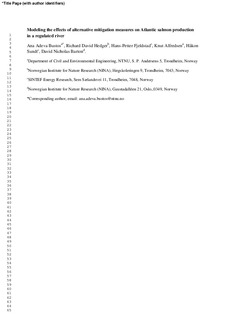| dc.contributor.author | Adeva Bustos, Ana | |
| dc.contributor.author | Hedger, Richard David | |
| dc.contributor.author | Fjeldstad, Hans-Petter | |
| dc.contributor.author | Alfredsen, Knut | |
| dc.contributor.author | Sundt, Håkon | |
| dc.contributor.author | Barton, David Nicholas | |
| dc.date.accessioned | 2018-02-06T08:11:30Z | |
| dc.date.available | 2018-02-06T08:11:30Z | |
| dc.date.created | 2017-02-07T18:49:31Z | |
| dc.date.issued | 2017 | |
| dc.identifier.citation | Water Resources and Economics. 2017, 17 32-41. | nb_NO |
| dc.identifier.issn | 2212-4284 | |
| dc.identifier.uri | http://hdl.handle.net/11250/2482829 | |
| dc.description.abstract | As part of the investigation of a new and optimized environmental flow regime in a regulated river (Mandalselva, Norway), a modeling study was conducted on the trade-offs between the production of Atlantic salmon (Salmo salar) smolts and the production of hydropower. Impacts of alternative flow regimes on smolt production were examined under different physical mitigation scenarios using the minimum flow regime recently proposed by the Norwegian Water Resources and Energy Directorate (NVE) as a baseline. Different combinations of hydropower operational strategies and/or physical mitigation measures were examined together with changes in the minimum discharge using a series of linked simulation models with the objective of finding combinations that both increased smolt production and maintained power production. This methodology provided a toolbox for predicting both the potential tradeoffs between smolt production and power production and therefore the evaluation of the most costeffective environmental flow regime. The main finding was that it was possible to achieve a similar smolt production with a lower hydropower plant flow release (with consequent lower power loss) than the flow regime proposed by the NVE. Introducing habitat modification measures further reduced the need for release of water in relation to the proposed minimum flow, while increasing the smolt production. In an economic cost-benefit analysis perspective, benefits per smolt from recreational fishing were small compared to hydropower costs per smolt, with hydropower losses determining optimal flow. This study concludes that the use of a modeling-based methodology to define a targeted environmental flow can be used to successfully balance the sometimes conflicting requirements of effective management of salmon populations while maintaining hydropower production. Energy production Atlantic salmon production Mitigation measures Cost-effectiveness comparison Fish benefit Trade-offs analysis | nb_NO |
| dc.language.iso | eng | nb_NO |
| dc.publisher | Elsevier | nb_NO |
| dc.rights | Attribution-NonCommercial-NoDerivatives 4.0 Internasjonal | * |
| dc.rights.uri | http://creativecommons.org/licenses/by-nc-nd/4.0/deed.no | * |
| dc.title | Modeling the effects of alternative mitigation measures on Atlantic salmon production in a regulated river. | nb_NO |
| dc.type | Journal article | nb_NO |
| dc.type | Peer reviewed | nb_NO |
| dc.description.version | acceptedVersion | nb_NO |
| dc.subject.nsi | VDP::Økonomi: 210 | nb_NO |
| dc.subject.nsi | VDP::Economics: 210 | nb_NO |
| dc.source.pagenumber | 32-41 | nb_NO |
| dc.source.volume | 17 | nb_NO |
| dc.source.journal | Water Resources and Economics | nb_NO |
| dc.identifier.doi | 10.1016/j.wre.2017.02.003 | |
| dc.identifier.cristin | 1448181 | |
| dc.relation.project | Norges forskningsråd: 215934 | nb_NO |
| dc.relation.project | Norges forskningsråd: 193818 | nb_NO |
| dc.description.localcode | © 2017. This is the authors’ accepted and refereed manuscript to the article. Locked until 7.2.2019 due to copyright restrictions. This manuscript version is made available under the CC-BY-NC-ND 4.0 license http://creativecommons.org/licenses/by-nc-nd/4.0/ | nb_NO |
| cristin.unitcode | 194,64,91,0 | |
| cristin.unitname | Institutt for bygg- og miljøteknikk | |
| cristin.ispublished | true | |
| cristin.fulltext | postprint | |
| cristin.qualitycode | 1 | |

